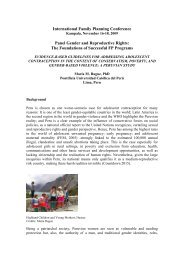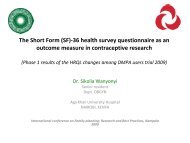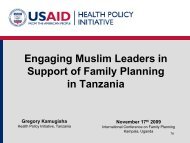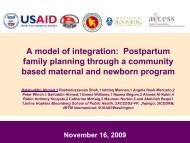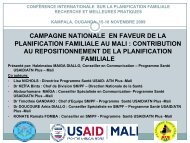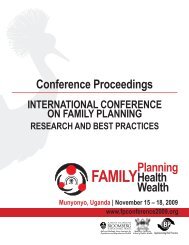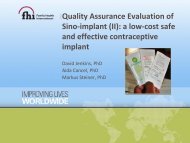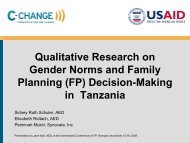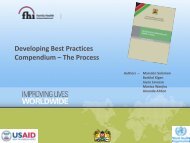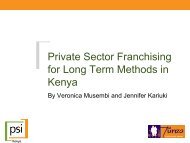Improving Family Planning Utilization by Repositioning
Improving Family Planning Utilization by Repositioning
Improving Family Planning Utilization by Repositioning
You also want an ePaper? Increase the reach of your titles
YUMPU automatically turns print PDFs into web optimized ePapers that Google loves.
<strong>Improving</strong> <strong>Family</strong> <strong>Planning</strong> <strong>Utilization</strong> <strong>by</strong> <strong>Repositioning</strong><br />
FP/RH Program through Strengthening Community-Based<br />
Health Service Extension Program (HSEP) in Ethiopia.<br />
/Best practice/<br />
Investigators: Dereje Ayele<br />
Dr. Ashenafi Negash<br />
Dr. Biniam Ayele<br />
16 th November 2008, Mekerere University, Uganda
Introduction<br />
The Project<br />
Outline of Presentation:<br />
Project Area and Population<br />
Main Objective of the Project<br />
Gaps Identified (baseline assessment)<br />
Major Activities<br />
Major Accomplishments<br />
Project Successes<br />
Conclusions/Recommendations<br />
Acknowledgement
Introduction<br />
Ethiopia is one of the countries<br />
high rate of morbidity and mortality<br />
high fertility<br />
Population = 73.9 million people (2 nd largest<br />
population in SSA, growing at 2.5 % resulting in 2<br />
million people added per year)<br />
CBR = 37.3 per 1000 with RNI of 2.5<br />
IMR = 77/1000<br />
CMR=50/1000<br />
U5MR= 123/1000<br />
MMR= 673/100,000<br />
NMR= 39/1000 live births
Introduction (cont…)<br />
Marriage at early age is slowly declining, from 65% of the<br />
married women being married <strong>by</strong> age 18 in 2000 to 61.8% in<br />
2005<br />
The contraceptive prevalence rate increased from 8.1% in 2000<br />
to 14.7% in 2005, but at 34% unmet demand remains high<br />
Potential health service coverage <strong>by</strong> public health facilities<br />
National - 76.9%<br />
ANRS (project region) - 74.5%<br />
Poor health service utilization<br />
Only 15% of married women are using some method of<br />
contraception the majority of which relying on modern<br />
methods (2005 DHS)
Introduction (cont…)<br />
Government endeavors to improve F/P services: Expanded<br />
coverage of family planning services to remote rural areas<br />
through;<br />
Deploying 30,000 female Health Extension Workers (HEWs)<br />
who are working at the house hold level<br />
Engaging the private sector and NGOs (abolishment of<br />
taxation on contraceptives)<br />
Linking HIV/AIDS and FP/RH services<br />
Expand the range of contraceptives available, including long<br />
term methods using the HSEP
Introduction (cont…)<br />
Health Service Extension Programme (HSEP):<br />
Introduced in 2004; An innovative community based heath care<br />
delivery system making essential Health Care universally accessible<br />
to individuals and families in the community <strong>by</strong> means acceptable<br />
to them through their full participation and at the cost that the<br />
community and the country can afford.<br />
It is a service delivered as a package of essential services targeting<br />
the households particularly women/mothers and children at the<br />
village/ Kebele level.
Introduction (cont…)<br />
… Health Service Extension Programme (HSEP):<br />
Four major health service package<br />
<strong>Family</strong> health services<br />
Communicable disease prevention and control services<br />
Hygiene and environmental health services<br />
Health education and communication services<br />
The family health service component encompasses<br />
Maternal health service,<br />
Delivery service<br />
Postnatal care<br />
Child care services<br />
<strong>Family</strong> planning services<br />
Adolescent reproductive health services<br />
Promotion of essential nutrition action
The Project
North & South Wello zones
Project Area and Population:<br />
Feature Total<br />
1 Total Population 4,571,345<br />
2 No of Woredas 34<br />
3 No of Kebeles 524<br />
4 No of HEWs on Job 1566<br />
5 No of Hospitals 5<br />
6 No of Health Centers 59<br />
7 No of Health Posts 635<br />
8 Cluster Health Center 120
Main Objective of the Project:<br />
To strengthen family planning program <strong>by</strong> improving<br />
performance of Health Extension Workers on<br />
reproductive health/family planning through training,<br />
supportive supervision, and dissemination of best<br />
practices, North & South Wello zones, 2006 – 2008/9.
Gaps Identified (baseline assessment):<br />
HEWs appear to have less theoretical knowledge on<br />
reproductive health<br />
Poor integration of services at the health post level<br />
Insignificant involvement of HEW’s in terms of<br />
service delivery for both maternal and child health<br />
care activities<br />
Low prevalence of current users (44.2%)<br />
High unmet need (26%)<br />
Low level of maternal health services (ANC,<br />
delivery, PNC)
Major Activities:<br />
Refresher training for Health Extension Workers<br />
S,M&E training for HEWs supervisors<br />
Training on RH/FP Leadership skills training for<br />
health managers at the district level<br />
Operational researches<br />
Production and dissemination of informational<br />
materials HEW Newsletter<br />
Advocacy campaigns<br />
Conduct supportive supervision
Major Accomplishments: Publications<br />
Trainer’s Guide for the refresher training of HEWs on RH/FP,<br />
HIV/AIDS, and Gender developed.<br />
Reference text for HEWs on RH/FP, HIV/AIDS, and Gender<br />
developed.<br />
Training manual and guideline on Supervision, Monitoring, and<br />
Evaluation for Health Extension Programme coordinators<br />
developed.<br />
Participant’s reference manual and work book and facilitator’s<br />
manual on “Leadership for health professionals working on<br />
RH/FP at Zonal and Woreda levels”.<br />
Quarterly Health Extension workers Newsletter distributed<br />
through out the country.<br />
Three operation researches are conducted & published.
Major Accomplishments: Trainings<br />
Type of Training Planned Achieved Organizations involved<br />
MDGs, Poverty reduction 31 31 World Bank, D&LPF,<br />
UNFPA, EPHA<br />
RH Program<br />
Management<br />
Supervision, M&E for<br />
HEW supervisors<br />
15 15 CAFS, Amhara RHB,<br />
EPHA<br />
40 37 AAU/SPH, Z&WHOs,<br />
EPHA<br />
RH/FP Leadership skills 111 93 Z&WHOs, EPHA<br />
RH/FP, HIV/AIDS,<br />
Gender (TOT)<br />
RH/FP, HIV/AIDS,<br />
Gender for HEW<br />
30 30 Z&WHOs, EPHA<br />
1566 1568 Z&WHOs, Pathfinder,<br />
FGAE, ADA, EPHA
Fig2:Trainings (planned Vs achieved, 2007-2009)
Fig3:In-service training of Health Extension<br />
Workers on RH/FP, HIV/AIDS, and Gender
Project Successes
HEWs gained knowledge and<br />
new skills on family planning<br />
service provision<br />
FP is integrated with other<br />
Health Extension packages and<br />
RH services at the household<br />
and HP level<br />
Improved clients demand for<br />
contraceptive methods<br />
Improved referral linkages<br />
Started sharing of resources and<br />
minimized duplication of<br />
efforts among stakeholders<br />
Project Successes:
Project Successes (cont…)<br />
Joint supportive supervision<br />
with the local health authorities<br />
became effective<br />
Ownership of the Health<br />
Extension Newsletter is<br />
transferred to the Ministry of<br />
Health, which resulted in<br />
increase of copies from 2000 to<br />
32,000 and increased coverage<br />
from the 38 villages (two<br />
zones) to 15,000 (nationwide)
Conclusions/<br />
recommendations
Conclusions and recommendations:<br />
This innovative collaborative model is improving family<br />
planning utilization<br />
<strong>Improving</strong> knowledge and skills of HEWs and their<br />
coordinators is critical to improve family planning services<br />
& coverage<br />
Reaching HEWs through Health Extension Newsletter to be<br />
used as one of the Ministry of Health outlet for<br />
disseminating important health issues, best practices &<br />
updates<br />
Supportive supervision and the system created for involving<br />
each actors working at the community level are critical to<br />
improve FP/RH
Acknowledgement:<br />
This project was a collaborative endeavor <strong>by</strong>;<br />
Ministry of Health<br />
The David & Lucile Packard Foundation<br />
Ethiopian Public Health Association
THANK YOU



